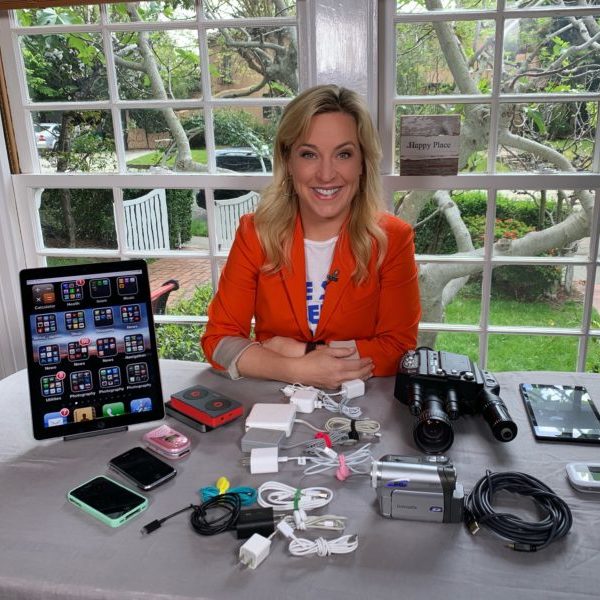
Thanks to decluttering diva Marie Kondo, Spring Cleaning is expected to hit an all-time high this year. A recent survey by the American Cleaning Institute shows a record 77 percent of households plan to clean-up, clear-out, and address the mess of our modern lives.
Since e–waste is the world’s fastest-growing trash stream, there’s an even stronger sense of renewed responsibility to declutter your e-clutter.
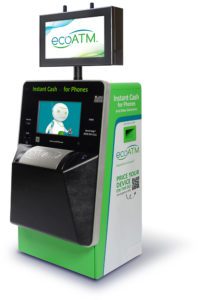
#1. CLEAR-OUT BEFORE YOU CLEAN-UP
One of the key trademarks of the “KonMari” method is to start by clearing-out everything unwanted and unused. Think about how much tech junk you have – that drawer full of dusty cell phones, charging cable chaos, and old earphones you haven’t touched since you used them with your 80’s Walkman. Pile them up, sort them, and then sell, trade, or recycle them.
There are dozens of ways to do this – but Gazelle has long been my go-to. It takes electronics ranging from smartphones to laptops and everything in between and gives you cold, hard cash in return. The service is stellar, and after you fill out the online forms to send an old device, they send you a prepaid mailer right away.
Gazelle also works hand-in-hand with ecoATM, a high-tech kiosk network that gives you cash on the spot as well. Go online to find a nearby ecoATM kiosk. There are thousands of them across the United States, including in many large chain stores like Walmart. Once you get to a kiosk, put your old phone into the machines’ testing area, and the ecoATM handles the rest. It examines your device and then offers you a price based on its condition. If you agree, you get cash right then and there. It even takes severely broken devices off your hands.
If you have a gadget bound for the trash heap, do the planet a favor and recycle it instead. Best Buy is one of the nation’s largest retail recyclers of used electronics and appliances, and takes all kinds of used tech, regardless of where you bought it, how old it is, or who made it. That’s huge because, by 2021, the annual e-waste total is predicted to surpass 60-million tons – the equivalent of 12-million elephants (or 321 Golden Gate Bridges).
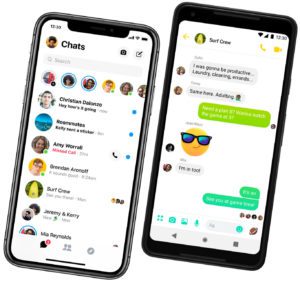
#2. APP-HOARDING HELP
Most of us are totally overwhelmed by the number of apps on our devices. Analytics company App Annie says the average person has as many as 90 apps on their smartphone, but only use around nine of them per day.
Start by ditching any apps you know you don’t use. I’m talking about apps you’ve never even opened — ones that might have come pre-installed on your phone — or apps you downloaded to try and never opened again. On iPhones, go to iPhone Storage through your general settings to see a list of apps that take up the most data and when you last used them. On Android devices, Google offers a similar tool called Files. When you see apps you’ve never used, or haven’t used in the last 3-6 months — get rid of them!
Next, look for apps that solve more than one problem and put them front and center. Facebook Messenger is a great example because it’s packed with features you might use several separate different apps for, such as sending money, video chatting, and sharing photos. You can also share your location to a friend using the maps feature or get customer support from a business that has a Facebook page. Facebook Messenger on Android can even handle SMS texts right inside the app, streamlining your chat habits too.
Once you identify how to get the most out of the multitasker-friendly apps you already have, ditch all the apps you just made obsolete and clean up your home screen in the process.

#3. DEEP CLEAN YOUR GROSS GADGETS
Now that you’ve purged and sorted, it’s time to deep-clean. You’ve heard by now that your smartphone is seven times dirtier than your toilet – and riddled with about 17,000 different types types of bacteria — right? I use two specific gadgets to keep my go-to tech tools pristine.
The HÄNS Swipe-Clean ($15) comes pre-loaded with tech-friendly cleaning solution, so you can just wipe down your smartphone, tablet, or other gadgets with cleaner, and then flip the HÄNS over and use the other end to dry and polish. It takes mere seconds but leaves everything squeaky clean.
To go even further, I use the PhoneSoap Go (around $80), a portable, battery-powered UV sanitizer that bathes your smartphone in ultraviolet light that eliminates 99.99% of household germs in 10 minutes. Stick your phone in the PhoneSoap box and the wavelengths of the UV light break down and destroy germs like E. Coli, Salmonella, Influenza, and even the Rhinovirus, which is responsible for the common cold.
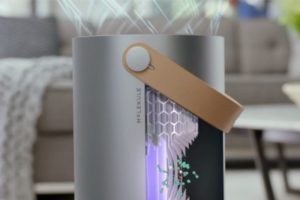
#4. SPARE YOUR AIR
You know what else is pretty yucky? Our indoor air-quality. The EPA warns that concentrations of some pollutants are up to five times higher inside our own homes, compared with outdoor air. The average person spends roughly 90 percent of their time inside, so shouldn’t your air be, you know, squeaky clean too?
For this, you might need to bring a new gadget into your home, so it’s perfect for after you purge and clean. I’ve been using the much-buzzed-about Molekule ($799), which claims to eliminate microscopic air pollutants. It uses a two-stage filter that traps both larger airborne nasties like pollen and pet hair and destroys the much smaller pollutants that standard filters typically miss. It’s been working miracles in our rented home that doesn’t have a fan in the kitchen and gets visibly smoky every time we cook on the stove. Not only is the smoke gone, but all my coughing at the dinner table has disappeared too.
The Blueair Blue Pure 211 ($299) is another solid choice, especially on a budget. It scrubs the air of 99 percent of “fine particles,” including smoke, dust, and mold, and uses an activated carbon filter to remove nasty odors for up to six months before needing a new filter. We reviewed this one during the Northern California fires last fall that had thick smoke hovering over the Bay Area for weeks. It also worked magic in our house and within one day, headaches cleared up for the entire family.
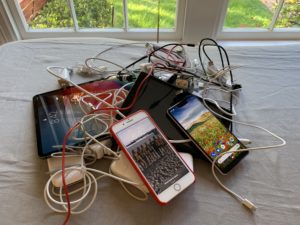
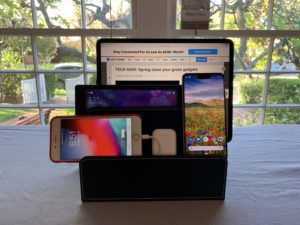
#5. CUT CORD CLUTTER CHAOS
Power cables are one of the biggest culprits of tech clutter in every household. Part of the problem is that we typically need different wires for products like smartphones, battery packs, cameras, and laptops and they either disappear or accumulate into one tangled mess. So – round ‘em up, purge, label, and give them a home.
I use TwistieMag (around $20) magnetic, reusable twist ties and rubber bands to keep cables and cords nice and neat. I also use a label maker to mark each cord, then stash everything that goes with each gadget into a Ziplock. Each tidy Ziplock then goes into Twill drawer organizer bins ($5-$13) that I pick up at the Container Store. They actually look quite fashionable sitting on my desk, or tucked-away in a drawer or on a shelf.
Charging stations are great, too. I use one large, nice looking leather docking station to put all of our family gadgets on at night – which helps get them out of bedrooms too (so they don’t disturb our sleep). The MobileVision station ($42.95) has multiple slots for several smartphones, tablets, and even a laptop. Just feed the cables into the bottom section, plug everything into the USB hub, and never worry about a twisted knot of cables near your wall outlet again.
WHAT’S LEFT?
I didn’t hit on one the biggest — and most overwhelming— tasks of all: sorting through all your digital photos and videos. That’s because I have so much trouble with this one myself, I had to call in an expert for added advice this year. Be sure to check back right here for that story — coming in the next few weeks. In the meantime, What are some ways you tackle your digital spring cleaning? Be sure to share all of your ideas in the comments section.
